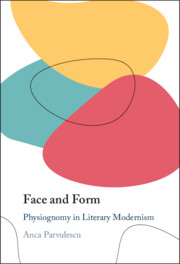Refine search
Actions for selected content:
10 results
Introduction
-
- Book:
- Face and Form
- Published online:
- 21 August 2025
- Print publication:
- 04 September 2025, pp 1-21
-
- Chapter
-
- You have access
- Open access
- HTML
- Export citation

Face and Form
- Physiognomy in Literary Modernism
-
- Published online:
- 21 August 2025
- Print publication:
- 04 September 2025
-
- Book
-
- You have access
- Open access
- Export citation
Chapter 8 - The Voice of Complaint
-
-
- Book:
- The Cambridge Companion to Romanticism and Race
- Published online:
- 21 November 2024
- Print publication:
- 28 November 2024, pp 130-149
-
- Chapter
- Export citation
6 - Making Faces, Performing Persons
- from Part II - The Truth Factory
-
- Book:
- The Making Sense of Politics, Media, and Law
- Published online:
- 06 April 2023
- Print publication:
- 13 April 2023, pp 111-136
-
- Chapter
-
- You have access
- Open access
- HTML
- Export citation
Chapter 3 - Cynthia and the Grotesque Ethos
-
- Book:
- The Grotesque in Roman Love Elegy
- Published online:
- 10 September 2020
- Print publication:
- 17 September 2020, pp 59-81
-
- Chapter
- Export citation
Chapter 5 - Revolting and Refined: The Aesthetic Function of Acanthis
-
- Book:
- The Grotesque in Roman Love Elegy
- Published online:
- 10 September 2020
- Print publication:
- 17 September 2020, pp 114-138
-
- Chapter
- Export citation
72 - Educational Practices: Rhetoric
- from Part VIII - High Culture
-
-
- Book:
- The Cambridge Guide to the Worlds of Shakespeare
- Published online:
- 17 August 2019
- Print publication:
- 21 January 2016, pp 560-566
-
- Chapter
- Export citation
Part XII - The Historical William Shakespeare
-
-
- Book:
- The Cambridge Guide to the Worlds of Shakespeare
- Published online:
- 17 August 2019
- Print publication:
- 21 January 2016, pp 829-870
-
- Chapter
- Export citation
Part VIII - High Culture
-
-
- Book:
- The Cambridge Guide to the Worlds of Shakespeare
- Published online:
- 17 August 2019
- Print publication:
- 21 January 2016, pp 537-606
-
- Chapter
- Export citation
109 - Education and Reading in Shakespeare’s Work
- from Part XII - The Historical William Shakespeare
-
-
- Book:
- The Cambridge Guide to the Worlds of Shakespeare
- Published online:
- 17 August 2019
- Print publication:
- 21 January 2016, pp 845-850
-
- Chapter
- Export citation
